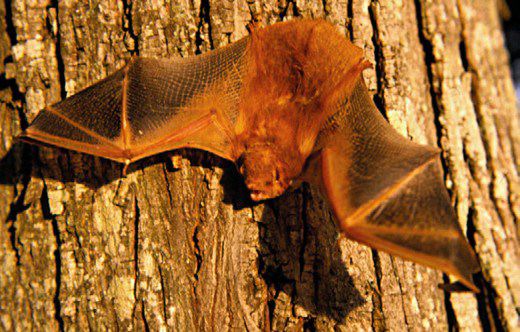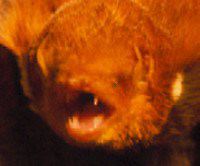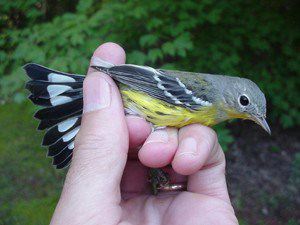|
|
|||
|
THIS WEEK at HILTON POND Installment #---Visitor # (Back to Preceding Week; on to Next Week) |
|
Mist nets used for catching wild birds are like giant hair nets hung between two poles. When properly deployed, the 7' x 42' contraptions snare almost anything that strikes them--including far too many falling leaves at this time of year. As we were closing our nets at Hilton Pond Center at sunset on 20 September, we noticed something unusual in a net near the old farmhouse. It didn't take long to realize it was neither a bird nor a leaf, but an agitated, squirming Red Bat!
Red Bats roost in trees, usually near water, and--unlike colonial bats--are solitary or found in small family groups. They are often discovered on the ground in daylight after they have fallen from the roost, especially in cool weather when their metabolisms make them sluggish. Red Bats hibernate in winter by wrapping themselves in their furry tail membranes, but they will rouse and forage during warm periods from November through March. While roosting or hibernating, they are sometimes taken by native predators such as hawks, owls, opossums, and Blue Jays, and tree-climbing feral house cats are a major enemy. Some Red Bats apparently migrate from colder parts of their range to southeastern states, where they still may hibernate. During summer, they "stick close to home"; researchers found that radio-tagged Red Bats foraged in a surprisingly small area of two acres or less.
All text & photos © Hilton Pond Center |


 Found throughout the U.S. east of the Rockies, Red Bats (Lasiurus borealis) are well-named, since all individuals are some shade of red. The male (shown in these photos) is more brightly colored but slightly smaller than the female. Bat size is very misleading, mostly because individuals are typically seen swooping about in poor light when it's hard to get perspective. The Red Bat in the picture above may seem huge, but the thumb in the photo above right provides scale and reveals the animal is only about 4" long, with a wingspan of about 12". A bat's long, thin fingers show clearly through its wing membranes, hence the Bat Order name Chiroptera ("hand wing").
Found throughout the U.S. east of the Rockies, Red Bats (Lasiurus borealis) are well-named, since all individuals are some shade of red. The male (shown in these photos) is more brightly colored but slightly smaller than the female. Bat size is very misleading, mostly because individuals are typically seen swooping about in poor light when it's hard to get perspective. The Red Bat in the picture above may seem huge, but the thumb in the photo above right provides scale and reveals the animal is only about 4" long, with a wingspan of about 12". A bat's long, thin fingers show clearly through its wing membranes, hence the Bat Order name Chiroptera ("hand wing"). Red Bats use echolocation and capture prey in their wing and tail membranes, shifting the food to their mouths while in flight. They feed primarily on insects less than 1" long, including beetles, moths, flies, and crickets. The tiny sharp teeth of a Red Bat easily crunch through an insect's exoskeleton, releasing the fat- and protein-rich meal that lies within.
Red Bats use echolocation and capture prey in their wing and tail membranes, shifting the food to their mouths while in flight. They feed primarily on insects less than 1" long, including beetles, moths, flies, and crickets. The tiny sharp teeth of a Red Bat easily crunch through an insect's exoskeleton, releasing the fat- and protein-rich meal that lies within.
